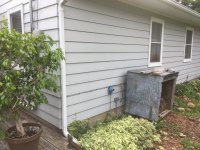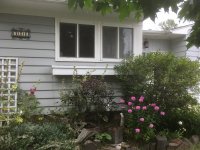Hi - (new here) - I want to direct vent an LP On Demand water heater with 2" PVC. Residential - Minnesota - will NOT be inspected but I'd like it "right" and "safe." I see the diagrams and tables regarding clearances etc. but I'm confused by 1. Are the clearance requirements the same for Exhaust AND Intake? 2. What is the rationale for clearance from an LP regulator? (exhaust? intake? both?). I'll try to attach two pictures here. "Front" is the one with pink flowers. The visible vent is a bathroom exhaust. The 2" pvc is a sump pump. The windows above the flower boxes are opened occasionally. The "Back" shows the regulator. Snow depth is a consideration in both. It would be more mitigated in the front by shrubs and flower boxes etc. The front is also much closer to installation point of heater. Back is about 20 feet away.... What are my best options??? Thanks VERY much, in advance, for ANYone's thoughts!!
You are using an out of date browser. It may not display this or other websites correctly.
You should upgrade or use an alternative browser.
You should upgrade or use an alternative browser.
HELP!? Direct venting On Demand Water Heater
- Thread starter ChuckGM
- Start date
Users who are viewing this thread
Total: 2 (members: 0, guests: 2)
Bannerman
Well-Known Member
You didn't state if your 'in demand' water heater is a condensing type or direct vent only. Condensing units will extract sufficient heat from the exhaust gases so the exhaust will be cool enough that PVC or CPVC pipe may be utilized whereas direct vent will continue to require heat-tolerant metal exhaust piping.
To ensure sufficient clearance from combustible building materials, direct vent appliances will often utilize a concentric metal venting arrangement where there is a wall penetration. This locates the warm/hot exhaust vent in the centre of a larger diameter outer pipe which will deliver cooler combustion air from the exterior.
A gas pressure regulator utilizes a flexible diaphragm to regulate the pressure of the gas in reference to atmospheric air pressure. Because the atmosphere side of the diaphragm is vented, if a rupture of the diaphragm should occur, that will allow unregulated gas to leak from the regulator's air vent. Leaking gas could be drawn into any nearby opening including the combustion air inlet to the WH or other gas appliance. If a nearby exhaust vent is hot, there is potential for leaking gas to be ignited.
The venting clearance distances from the regulator are to ensure sufficient opportunity for leaking gas to dissipate without being drawn into the home or combustion device. or creating a combustion hazard on the outside of the building.
To ensure sufficient clearance from combustible building materials, direct vent appliances will often utilize a concentric metal venting arrangement where there is a wall penetration. This locates the warm/hot exhaust vent in the centre of a larger diameter outer pipe which will deliver cooler combustion air from the exterior.
A gas pressure regulator utilizes a flexible diaphragm to regulate the pressure of the gas in reference to atmospheric air pressure. Because the atmosphere side of the diaphragm is vented, if a rupture of the diaphragm should occur, that will allow unregulated gas to leak from the regulator's air vent. Leaking gas could be drawn into any nearby opening including the combustion air inlet to the WH or other gas appliance. If a nearby exhaust vent is hot, there is potential for leaking gas to be ignited.
The venting clearance distances from the regulator are to ensure sufficient opportunity for leaking gas to dissipate without being drawn into the home or combustion device. or creating a combustion hazard on the outside of the building.
Sponsor
Paid Advertisement
Fitter30
Well-Known Member
Read all the danger and warning notes in the manual. Flue and intake have to be on the same side of the house so there at the same pressure. Front of the house will exhaust on plants not good plus when windows are open right underneath fumes might enter under the right conditions. Intake doesn't have any clearance requirements except the 12" away from the exhaust inless using a concentric flue fitting. Regulator needs the vent open not blocked by snow vent is pointed down so it doesn't collect water and freeze.
You didn't state if your 'in demand' water heater is a condensing type or direct vent only. Condensing units will extract sufficient heat from the exhaust gases so the exhaust will be cool enough that PVC or CPVC pipe may be utilized whereas direct vent will continue to require heat-tolerant metal exhaust piping.
To ensure sufficient clearance from combustible building materials, direct vent appliances will often utilize a concentric metal venting arrangement where there is a wall penetration. This locates the warm/hot exhaust vent in the centre of a larger diameter outer pipe which will deliver cooler combustion air from the exterior.
A gas pressure regulator utilizes a flexible diaphragm to regulate the pressure of the gas in reference to atmospheric air pressure. Because the atmosphere side of the diaphragm is vented, if a rupture of the diaphragm should occur, that will allow unregulated gas to leak from the regulator's air vent. Leaking gas could be drawn into any nearby opening including the combustion air inlet to the WH or other gas appliance. If a nearby exhaust vent is hot, there is potential for leaking gas to be ignited.
The venting clearance distances from the regulator are to ensure sufficient opportunity for leaking gas to dissipate without being drawn into the home or combustion device. or creating a combustion hazard on the outside of the building.
Thank you for your response - I guess I'll reply to each of you separately with the same info... (I'm not sure how this works...) - anyway. I'm glad I'm looking into this here. It is a condensing unit. I understand the regulator thing now. My understanding is that intake and exhaust need to come out of the same side of the house... Re. the option in the front of the house: Your concerns were that it wouldn't be good for plants and that open windows above exhaust could be problematic. That seems reasonable to me but isn't it true that (in the U.S.) all I have to be is 12 inches below or to the side of an operable window?? (see attached photo of ny install manual). As I see it now, all three options that I see are "problematic." 1. If I come out the back of the house I've got the regulator. I suppose I could run the pvc up and away and around the soffit to the left but besides looking bad, I imagine I'd be too close to electric service and would have to extend a good ways above roof (?)... I could come out the back and run the pvc to the right behind the firewood bin and terminate them between those two bedroom windows...? 2. The "front" with the plants and windows explained above or 3. (see pictures) the "side" by chimney - where I would have to stay to the right of chimney (furnace on left) and it would require a run of about 40 feet and would make the 1/4" per foot slope requirement difficult...
--- Anymore thoughts? :-(
I wasn't certain if you would get notice that I responded to the thread so I just wanted to alert you to please take a look at my response - THANKS!!Read all the danger and warning notes in the manual. Flue and intake have to be on the same side of the house so there at the same pressure. Front of the house will exhaust on plants not good plus when windows are open right underneath fumes might enter under the right conditions. Intake doesn't have any clearance requirements except the 12" away from the exhaust inless using a concentric flue fitting. Regulator needs the vent open not blocked by snow vent is pointed down so it doesn't collect water and freeze.
Fitter30
Well-Known Member
If u come out by the regulator the regulators vent is threaded and has a screen and a clip that holds it. The threads are 1/2" female pipe thread just pipe it away just put the screen in the outlet.
I'm not understanding this... I could come out by the regulator and pipe it to the right but then I get close to those other windows - (?) - What does your reference to the regulator's vent have to do with my issue?If u come out by the regulator the regulators vent is threaded and has a screen and a clip that holds it. The threads are 1/2" female pipe thread just pipe it away just put the screen in the outlet.
Fitter30
Well-Known Member
Yes code
I'm imagining galvanized is easiest/best...?Yes code
Last edited:
Similar threads
- Replies
- 7
- Views
- 1K
- Replies
- 3
- Views
- 326
- Replies
- 6
- Views
- 1K
- Replies
- 11
- Views
- 2K
- Replies
- 12
- Views
- 213


